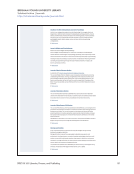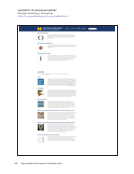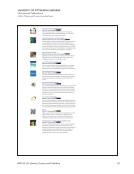58 Survey Results: Survey Questions and Responses
Open access is greatly valued by the university community and others. Selected platform for delivering
information can be useful in generating enthusiasm and support for open access.
Open access scholarly publishing is a natural fit with research libraries.
Our support for journal publishing is basic—a platform for managing online journals, support of DOAJ
inclusion, DOI registration, Portico inclusion. This approach is scaling well in that adding new journals
is relatively straightforward and most of the effort is in the start up with a new journal. While our basic
journal support has scaled well, we have found it more difficult to successfully engage with scholars who
have approached us with less concrete digital scholarship projects that fall outside our service model.
While there is some overlap, such projects require very different commitments.
Publishing expertise is amazing, and the institutional press should be consulted whenever possible.
Even simple things like specific terminology (e.g., defined difference between publishing and publishing
services) are critical to understanding for planning programmatic implementation of library publishing,
and for dealing with complications. “The author always has more time than you do.” Wisdom shared
from the press, which encapsulates the need for programmatic supports, especially when dealing with
difficult or time-demanding authors. There is a vast array of low-hanging fruit for library and press
collaboration, as with enhanced monographs where the libraries can provide hosting/preservation for
digital files that complement the press. With shared missions and goals, collaborating on the simple
areas is a fabulous way to open conversations for more collaboration that is even higher impact.
Some faculty will want to control parts of their own local publishing activities that are better executed
and managed by librarians, which means duplication of effort. They must be sold on the idea of letting
someone else provide the service. Most faculty do not understand principles of copyright, and they are
not interested in learning about it—nor do they have the time. Sometimes this can be an impediment
(e.g., if they decide students transfer their copyrights to ProQuest with ETD submissions). When
working with researchers on data publication, you need to understand their concerns and points of view,
but the content delivered must have value. There needs to be some middle ground what is that and how
do you get there? This consideration often comes into play.
Stakeholder consensus about the audience, purpose, and goals of a project are essential at the beginning
of any publishing endeavor. Developing a campus of awareness about library publishing services
requires patience.
Standard publishing contracts are needed—and best to have them signed/in place with parties early, so
that expectations and performance (deadlines) are clear on all sides. Best to have an acquisitions strategy
in place for OAJs, OERs, and other areas, e.g., aligned well with institution’s core strengths and standout
departments. Build and nurture relationships with vendors (attend professional publishing conferences)
to improve services and aggregate need (to gain leverage in negotiations and improve stewardship
of resources).
The library press and institutional press need to be coordinating and centralized enough in location and
interaction to understand the opportunities that exist for synergistic activities. To be successful in open
access publishing you need to be flexible and open to different models along the open access spectrum
to achieve success for new models in support of campus practices. There is no single solution to OA.
The library press and institutional press partnership should be seamless to faculty in terms of where the
service is being supported.
The need to provide complementary services, such as editing, design, etc. The need to partner with
others on campus and beyond (nationally and globally).
There is an increased demand for these services with more requests than ever, but our current technical
capabilities are not adequate for the demand.
Open access is greatly valued by the university community and others. Selected platform for delivering
information can be useful in generating enthusiasm and support for open access.
Open access scholarly publishing is a natural fit with research libraries.
Our support for journal publishing is basic—a platform for managing online journals, support of DOAJ
inclusion, DOI registration, Portico inclusion. This approach is scaling well in that adding new journals
is relatively straightforward and most of the effort is in the start up with a new journal. While our basic
journal support has scaled well, we have found it more difficult to successfully engage with scholars who
have approached us with less concrete digital scholarship projects that fall outside our service model.
While there is some overlap, such projects require very different commitments.
Publishing expertise is amazing, and the institutional press should be consulted whenever possible.
Even simple things like specific terminology (e.g., defined difference between publishing and publishing
services) are critical to understanding for planning programmatic implementation of library publishing,
and for dealing with complications. “The author always has more time than you do.” Wisdom shared
from the press, which encapsulates the need for programmatic supports, especially when dealing with
difficult or time-demanding authors. There is a vast array of low-hanging fruit for library and press
collaboration, as with enhanced monographs where the libraries can provide hosting/preservation for
digital files that complement the press. With shared missions and goals, collaborating on the simple
areas is a fabulous way to open conversations for more collaboration that is even higher impact.
Some faculty will want to control parts of their own local publishing activities that are better executed
and managed by librarians, which means duplication of effort. They must be sold on the idea of letting
someone else provide the service. Most faculty do not understand principles of copyright, and they are
not interested in learning about it—nor do they have the time. Sometimes this can be an impediment
(e.g., if they decide students transfer their copyrights to ProQuest with ETD submissions). When
working with researchers on data publication, you need to understand their concerns and points of view,
but the content delivered must have value. There needs to be some middle ground what is that and how
do you get there? This consideration often comes into play.
Stakeholder consensus about the audience, purpose, and goals of a project are essential at the beginning
of any publishing endeavor. Developing a campus of awareness about library publishing services
requires patience.
Standard publishing contracts are needed—and best to have them signed/in place with parties early, so
that expectations and performance (deadlines) are clear on all sides. Best to have an acquisitions strategy
in place for OAJs, OERs, and other areas, e.g., aligned well with institution’s core strengths and standout
departments. Build and nurture relationships with vendors (attend professional publishing conferences)
to improve services and aggregate need (to gain leverage in negotiations and improve stewardship
of resources).
The library press and institutional press need to be coordinating and centralized enough in location and
interaction to understand the opportunities that exist for synergistic activities. To be successful in open
access publishing you need to be flexible and open to different models along the open access spectrum
to achieve success for new models in support of campus practices. There is no single solution to OA.
The library press and institutional press partnership should be seamless to faculty in terms of where the
service is being supported.
The need to provide complementary services, such as editing, design, etc. The need to partner with
others on campus and beyond (nationally and globally).
There is an increased demand for these services with more requests than ever, but our current technical
capabilities are not adequate for the demand.



















































































































































































